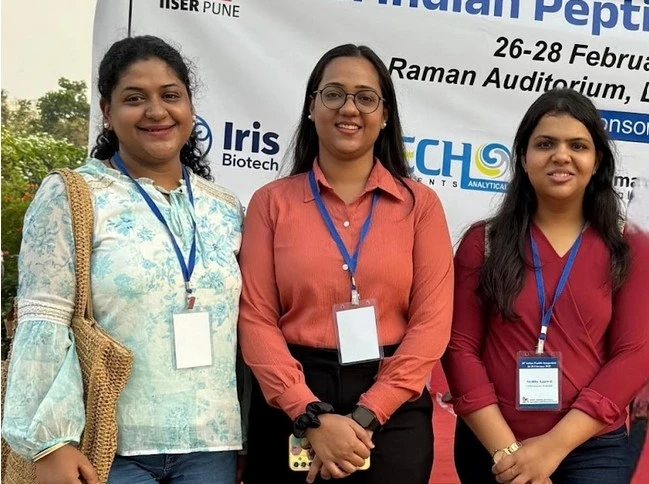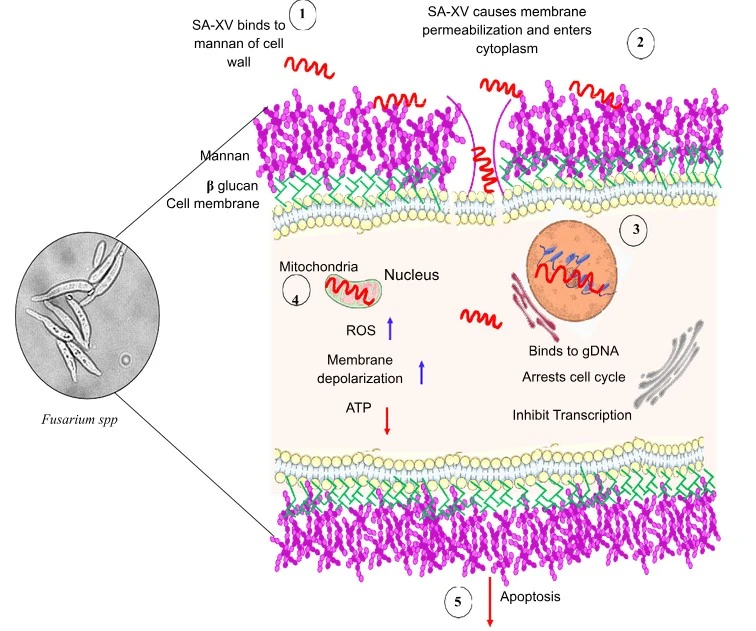Research Summary: SA-XV, a 15-residue of host defense peptide S100A12, shows potent antifungal activity by targeting fungal membranes, DNA, and mitochondria, induces ROS, promotes corneal healing, and reduces fungal keratitis burden in-vivo.
Author interview

Riddhi Agarwal, Akshita Agrawal, Karishma Biswas
Riddhi Agarwal is a PhD scholar and Akshita Agrawal is a project fellow in the Dr CNR Ocular Pharmacology lab, L V Prasad Eye Institute, Hyderabad. Their work mainly focuses on understanding host- pathogen interaction and alternate therapeutics for fungal keratitis. Dr. Karishma Biswas is a postdoctoral fellow working in collaboration with Dr. Anirban Bhunia Lab at Bose Institute.
Linkedin:
http://www.linkedin.com/in/akshita-agrawal16n041999s
https://www.linkedin.com/in/riddhi-agarwal-26b66a24a
Twitter: @akshita1699, @RIDDHIA79109299
Lab: Dr. Sanhita Roy, LV Prasad Eye Institute, Hyderabad
What was the core problem you aimed to solve with this research?
Fungal corneal infections (keratitis) is a significant global health burden, leading to vision loss and blindness, particularly in developing countries. Current antifungal therapies are limited by high toxicity, low bioavailability, and, most critically, the rapid emergence of antifungal resistance. This situation is especially dire in countries like India, where Fusarium and Candida species are among the leading causes of fungal keratitis and are now recognized by the WHO as priority fungal pathogens. Therefore, our research specifically aimed to address this unmet medical need by exploring antimicrobial peptides—in particular, SA-XV, a short fragment of S100A12—as an alternative therapeutic intervention with unique mechanisms of action, low toxicity to host cells, and therapeutic potential for managing fungal keratitis.

How did you go about solving this problem?
We have been working on antimicrobial peptides, both natural and synthetic, for a long time. We have earlier identified the natural peptide S100A12 to be effective against fungus. In this study, we focussed on short fragments of S100A12, to overcome few challenges like costly synthesis of big protein and corneal penetration. Shorter segments of S100A12 were analysed to identify regions that retained antifungal activity. Through this process, we discovered a 15-amino-acid fragment, SA-XV, which preserved the critical antifungal functions of the parent peptide.
Once identified, SA-XV was subjected to detailed functional characterization. We tested its activity against both filamentous fungi (Fusarium spp.) and non-filamentous fungi (Candida spp.) to assess the spectrum of its antifungal action. The mode of action of this peptide was studied in great detail. We also tested its safety and efficacy using our established mouse model of corneal infections and found the peptide to be effective in curbing infections.
Fungal eye infections are a major cause of blindness in India and globally. Our study shows huge promises for short peptides to treat fungal infections and avoid blindness. — Dr. Sanhita Roy
How would you explain your research outcomes (Key findings) to the non-scientific community?
Eye infections caused by fungus are a significant socio-economic burden, causing thousands of people to lose their vision yearly. In the Indian subcontinent, fungal eye infections disproportionately affect agricultural workers and labourers exposed to dust, plant material, and eye injuries. India’s warm, humid climate creates ideal conditions for fungi like Fusarium to grow, further fuelling the spread of these infections. We have identified a small but powerful solution: a tiny peptide derived from a natural human protein called S100A12. Despite its small size, SA-XV acts like a molecular weapon: It attaches to the fungal cell wall, punches through its protective membranes and damages vital cell machinery, like DNA and mitochondria, effectively killing the fungus. What makes this more exciting is that SA-XV not only kills fungi but also helps in healing of damaged tissue and is not harmful to human cells.
What are the potential implications of your findings for the field and society?
For the field – The path to discover new antifungals is not very easy due to various reasons. However, the need for new drugs is very evident. Our findings suggest that short peptides like SA-XV could make the way for a whole new generation of antifungal therapies. What makes it special is that it attacks fungi in several different ways at once, which means the pathogens are far less likely to develop resistance.
For society – Many people suffer from fungal infections and often lose their sight to these infections. In practical terms, our findings could one day be formulated into something as simple as an eye drop to treat fungal keratitis, potentially reducing the number of patients who end up needing corneal transplants. Beyond eye infections, peptides like SA-XV could inspire safer, more versatile antifungal treatments at a time when drug resistance is a growing global threat. Given that fungal infections kill millions of people worldwide every year, advances like this could have a real impact on public health and quality of life.
What was the exciting moment during your research?
The first most exciting moment was when we saw under the microscope that the peptide was successful in inhibiting fungal growth. However, the excitement increased when we discovered its mechanism, that SA-XV enters the fungal cell, binds directly to its nucleus, and blocks vital processes like transcription and cell division. Seeing this confirmed through DNA-binding assays was truly fascinating. Additionally, when we saw how well the peptide worked in the mouse model of corneal infection and helped in healing the corneal wounds, we were very excited.
Together, these findings made us realize we were uncovering a completely novel mechanism of antifungal action.
Paper reference: Agarwal R, Biswas K, Agrawal A, Shankar NN, Kundu S, Roy D, Son D, Harikishore A, Yennamalli RM, Lee D, Bhunia A, Roy S. SA-XV, a 15-amino acid fragment of host defense peptide S100A12, targets mitochondria, and is protective against fungal infections. J Biol Chem. 2025 Sep 18:110743. doi: 10.1016/j.jbc.2025.110743. Epub ahead of print. PMID: 40975173.
Link: https://www.jbc.org/article/S0021-9258(25)02595-5/fulltext
Explore more
🎤 Career – Real career stories and job profiles of life science professionals. Discover current opportunities for students and researchers.
💼 Jobs – The latest job openings and internship alerts across academia and industry.
📢 Advertise with BioPatrika – Reach the Right Audience, Fast!
🛠️ Services – Regulatory support, patent filing assistance, and career consulting services.




